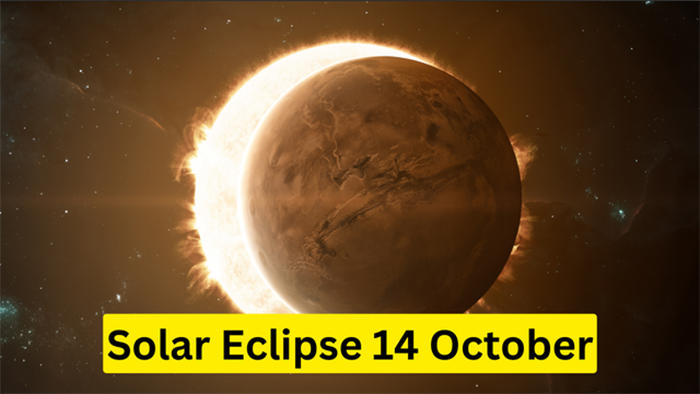Solar Eclipse 14 October 2024 : Astronomy enthusiasts have a rare celestial treat to look forward to on October 14, 2024. This day will witness a “ring of fire” eclipse, also known as a partial solar eclipse, occurring for the first time since May 20, 2012. The event is expected to be visible across most of the Americas and will feature the moon passing in front of the sun, covering a significant portion of it. This creates an impressive ring or annulus that promises to be an awe-inspiring experience for those who witness it. According to the Washington Post, this cosmic phenomenon is sure to leave observers spellbound. Preparing for such events requires careful planning and taking necessary safety precautions like using special eclipse glasses or filters to avoid damaging your eyesight when looking at the sun directly during the eclipse.
Are you ready for a celestial spectacle? On October 14, 2024, the sky will put on a show that you don’t want to miss – a solar eclipse! This rare event occurs when the moon passes between the Earth and the sun, casting a shadow on our planet. It’s a breathtaking sight that has captivated people throughout history. In this blog post, we’ll delve into the details of the upcoming solar eclipse, including where it will be visible, how to safely view it, and what makes this particular eclipse so special. So mark your calendars and get ready to witness nature’s most awe-inspiring phenomenon – the solar eclipse of October 14, 2024!
Solar Eclipse 14 October 2024
On October 14, 2024, an annular solar eclipse will occur, which is when the Moon moves between the Earth and the Sun, causing a complete or partial blockage of the Sun’s image from the perspective of observers on Earth. During this type of eclipse, the Moon covers most of the Sun’s light, creating a ring-like appearance when the Moon appears smaller than the Sun. This phenomenon is known as an annular solar eclipse. Within a wide area spanning hundreds of kilometers or miles, an annular eclipse will be visible as a partial eclipse.
On October 10, 2024, a rare celestial event will occur when a solar eclipse takes place that will be visible to millions of people in the Western Hemisphere. The eclipse will be slightly smaller than the apparent diameter of the Moon and will occur only 4.6 days after apogee. This remarkable occurrence can be witnessed in many parts of the United States, Mexico, and other South and Central American nations. Peg Luce, the interim head of NASA’s Heliophysics Division, has described it as “the awe and the wonder of seeing a beautiful ring of fire Solar Eclipse” that many people will have the opportunity to witness.
Solar Eclipse 14 October 2024 Details
| Article Name | Solar Eclipse 14 October 2024 |
| Category | News |
| Official Website | Click Here |
 |
|
| Telegram |
Also Check: Basilic Fly Studio IPO Allotment Status
Surya Grahan 2024 in India Date and Time
In October of this year, astronomy enthusiasts and stargazers are in for a double celestial treat as there will be both a solar and lunar eclipse occurring. Unfortunately, India will not be able to witness the solar eclipse known as the “ring of fire” in person. However, interested individuals can watch it live through the official NASA webcast, which begins at 4:30 p.m. on October 14, 2024, on their YouTube channel. While India may miss out on this spectacle, they can still witness the lunar eclipse that is set to occur on November 19th of this year.
- Date Of Oct 2024 Solar Eclipse: Oct 14, 2024
- Sunset Eclipse Start of October 2024 (New Delhi): October 14, 2024, 11:29 PM
- End of the October 20, 2024, solar eclipse (New Delhi): October 14, 2024, 11:34 PM
A solar eclipse refers to the phenomenon where the moon moves between the sun and Earth, causing a partial or total obstruction of the sunlight. On the other hand, an annular eclipse occurs when the sun appears to form a ring around the moon due to the moon’s slightly smaller size compared to the sun.
Check Here: Chandrayaan-3 launch 2024
Ring Of Fire To Be Visible In?
To witness the awe-inspiring “ring of fire” solar eclipse phenomenon, Space.com suggests heading to the southwestern region of the United States or to the Mayan temple in Edzna, locate on the Yucatan Peninsula in Mexico. The duration and timing of the event will determine which cities and areas will have the best views of the ring of fire. It is important to note that viewers should take proper safety precautions when observing solar eclipses, such as using special glasses or filters to protect their eyes from harmful radiation.
Aside from the brief occurrence of the “ring of fire,” each location that experiences a solar eclipse will also go through an extend period of partial eclipse. The duration of this partial eclipse depends on the location’s proximity to the centerline of annularity. The closer the location is to this line, the longer the ring of fire experience will last. It is important to note that viewing a solar eclipse without proper protective eyewear can result in severe eye damage, so it is imperative to take necessary precautions before viewing this phenomenon.
Look Here: Atiq Ahmed Encounter
When is the Next Annular Solar Eclipse (Ring Of Fire)?
The second annular solar eclipse is set to occur on October 2, 2024, following the eclipse that will take place on October 14, 2024. During this event, viewers locate in the Pacific Ocean, southern Chile, and southern Argentina will witness a “ring of fire.” This ring of fire will last for an impressive seven minutes and twenty-five seconds at the point of maximum eclipse over the ocean. The spectacle of a solar eclipse is always a unique experience and one that should not be miss by anyone with an interest in astronomy or celestial events.
The “ring of fire” solar eclipse is a rare celestial event that can be seen from different parts of the world. However, the best place to observe it is Easter Island (Rapa Nui), which is locate around 2,000 miles (3,200 km) west of the Chilean coast. Visitors to Easter Island will have a unique opportunity to witness the “ring of fire” for up to six minutes and nine seconds while surround by an isolate volcanic environment that boasts countless carve moai sculptures. It’s an experience that should not be miss by anyone interest in astronomy or natural wonders.
Read More: 10 Hardest Countries to Get Citizenship in the World 2024
Safety Measures During An Annual Eclipse
- During an annular solar eclipse, the Sun is never completely obscure by the Moon. Therefore, it is crucial to exercise caution and avoid direct eye contact with the Sun without proper protection.
- To safeguard one’s eyes from lasting damage, it is crucial to utilize eclipse glasses that are design exclusively for viewing the sun.
- According to NASA, these eclipse glasses are significantly darker than regular eyeglasses and should have the ISO reference number 12312-2 print on them.
- Using a camera, telescope, binoculars, or any other optical equipment to look at the Sun is strongly discourage due to the potential risks it poses to one’s eyes and the possibility of damaging the protective filter.
- The use of a pinhole projector is an extra precautionary method to observe the eclipse safely.
Conclusion
During this rare event, the moon will pass between the sun and the Earth, casting its shadow and temporarily blocking out the sun’s light. As the moon aligns perfectly with the sun, observers in certain parts of the world will be treated to a breathtaking sight. The sky will darken, temperatures may drop, and a sense of awe and wonder will fill the air. It is important to remember to observe this phenomenon safely by using proper eye protection or watching a live stream. So mark your calendars and prepare for an unforgettable experience as nature puts on a mesmerizing show in the form of a solar eclipse on October 14, 2024.
Solar Eclipse 14 October FAQ’S
What time is the eclipse on October 14 2024 in India?
The Solar Eclipse is happening on 14 October 2024 from 11:29 PM to 11:37 PM (Indian time). This time there will be only certain locations where this eclipse will be visible. Only a very select few locations will be able to observe the solar eclipse of 2024.
Is there Surya Grahan on 14 October 2024?
India will not be able to witness the annular solar eclipse in 2024 (File photo). Mark your calendars for October 14, 2024, as that is when a solar eclipse or surya grahan is set to take place. During a solar eclipse, the moon moves in front of the sun, resulting in a temporary blockage of its light.
What will happen on 14th October 2024?
The next solar eclipse in 2024 will take place on October 14th. It will begin at 8:34 PM on the 14th and end early in the morning at 2:25 AM on October 15th. The duration of this eclipse will be approximately six hours. Unfortunately, this particular solar eclipse in 2024 will not be visible in India.
What is the time of Surya Grahan in India 2024?
Drik Panchang, the last solar eclipse of 2024 will begin at 8:34 PM on October 14 and last until 2:25 AM on the October 15, making for a nearly six-hour celestial spectacle.
Related Post:
Aditya L1 Mission, Launch Date
